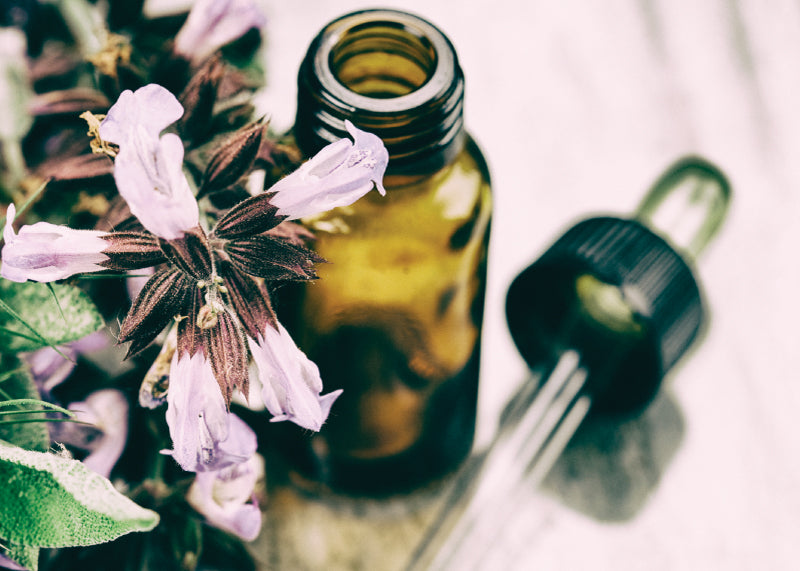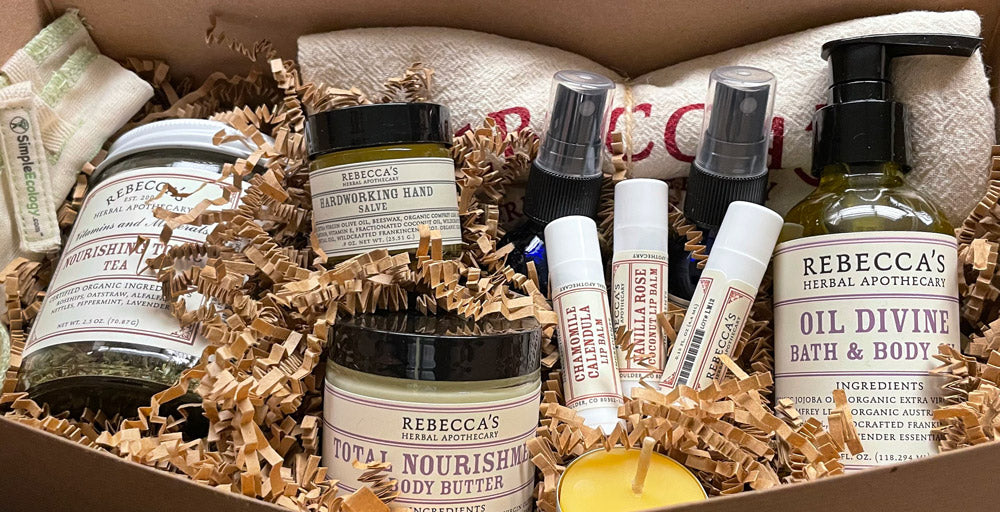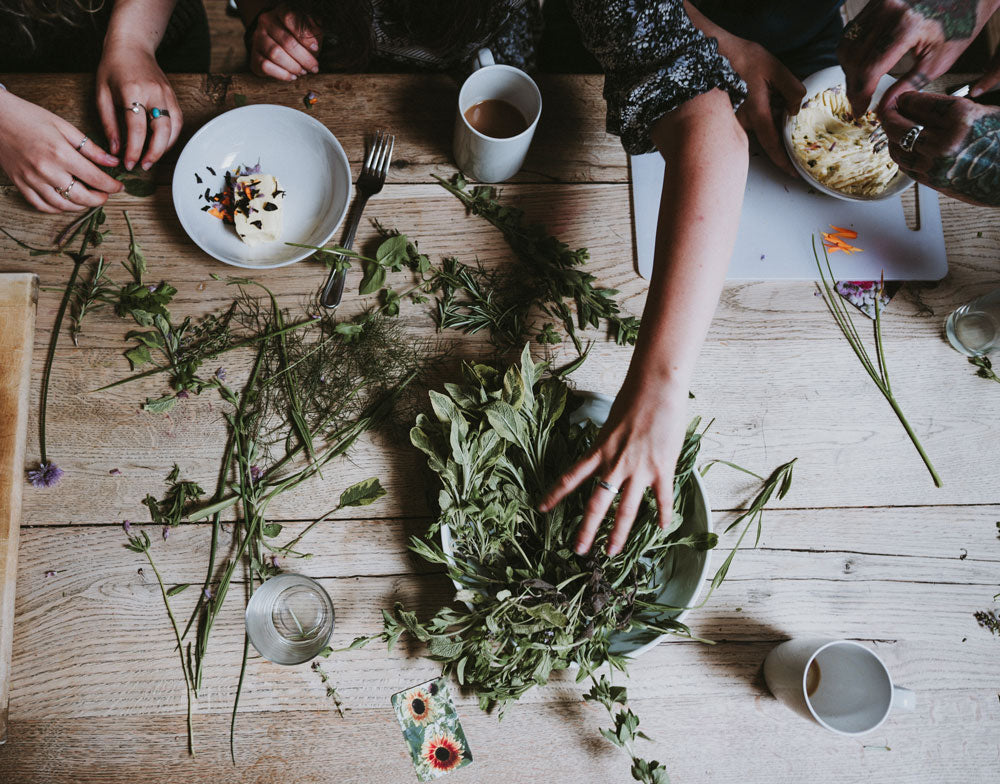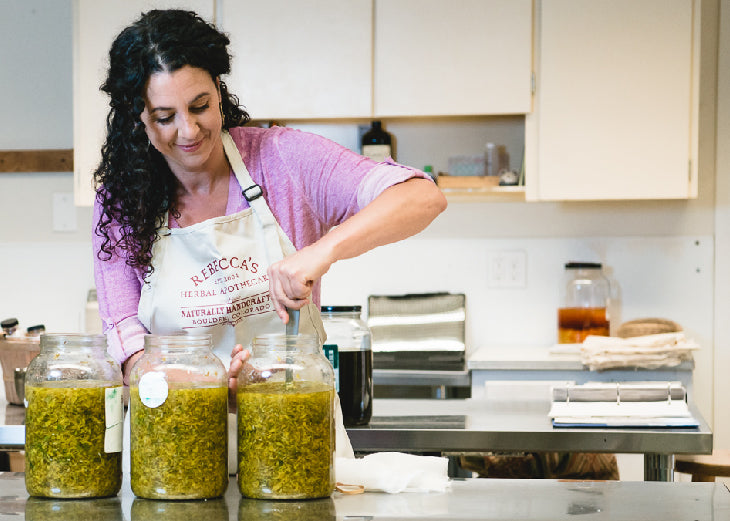Herb Article
Calendula II
By Christina Bertelli, Certified Clinical Herbalist
Family: Asteraceae
Parts Used: Flowers
Calendula prolifically produces flowers that are golden yellow to bright orange in color. The blossoms open at sunrise. Brigitte Mars supposes that its Latin genus name, which comes from calendae, meaning the first day of the month, is derived from the fact that there are Calendula flowers blooming every month somewhere around the globe. Calendula is native to Southern Europe along the Mediterranean. It has also been called Pot Marigold, Scotch Marigold, Holigold, Gowan, Ruddles and Bull's Eye. Although it is a wonderful and easy plant to grow in your garden (excellent as a natural pest deterrent) it is very different from the common garden marigolds your mom may have grown in pots on your porch.
The use of Calendula officinalis dates back to ancient Egypt and 12th century Europe. The yellow flowers have been employed to dye fabrics, cosmetics, hair, cheese and margarine. Medicinally, Calendula is a treasured herb because it has a wide variety of useful applications. Externally it is an anti-inflammatory, anti-microbial and wound-healing herb of great repute. Calendula encourages the body to clean, stitch and repair broken skin. It is very commonly the primary herb in a skin salve. Dry, itchy skin is another indication for the use of Calendula. Lesley Tierra states that the application of the tincture to her son's chicken pox cleared the eruptions and relieved the itching rapidly. Other indications include: rashes, skin fungus, herpes blisters, burns, boils, measles, varicose veins, diaper rash, and red, irritated eyes.
We also love Calendula for its internal wound-healing and anti-inflammatory effects on the intestinal lining, our inner skin benefits as well! A primary herb for a digestive healing tea, calendula is especially helpful when someone has been struggling with food allergies and food sensitivities. Calendula will seal the permeations known as "leaky gut" while also acting as a mild liver cooler and cleanser and excellent lymphatic herb. The liver and lymph invariably get congested as a side effect of food allergies. The immune system will benefit from a nice cup of Calendula tea as it contains immunomodulating polysaccharides as well. To top it all off, the visual of bright orange flowers floating in water will surely bring a happy, sunny disposition to your day!
Preparations & Applications
Infusion: 1-2 Tablespoons / cup water infused for 40 min. to overnight. Drink 1 cup every hour until acute symptoms subside 2-4 cups per day.
Fomentation/Compress: Make an infusion of 1oz herb to 1 quart water. Soak a washcloth in the tea and apply locally to irritated skin. A fresh plant oil application can be made by blending fresh mortared flowers and olive oil and used as a poultice for minor cuts, scraps and scratches.
Tincture: Can be applied externally, added to lotions and salves; internal dose is 30 drops 4xday.
Essential oil: External use, 10-20 drops per carrier oil or lotion
Infused oil: Apply to dry, irritated skin, rashes, eczema, herpes blisters
Recipes
Very Special Skin Oil
1 oz Calendula infused olive oil
12 drops Lavender essential oil
8 drops German Chamomile essential oil
8 drops Palmarosa essential oil
5 drops Helichrysum essential oil
Use for non-specific rashes, irritated, red, hot eczema. Combine with treatments to nutritionally address the issues internally. Never include Helichrysum if skin is open.
Sources:
Herbal Vade Mecum by Gazmend Skenderi
Healing With The Herbs of Life by Lesley Tierra
The Herbal Desk Reference by Brigette Mars
 Calendula, Calendula officinalis
Calendula, Calendula officinalis
Family: Asteraceae
Parts Used: Flowers
Calendula prolifically produces flowers that are golden yellow to bright orange in color. The blossoms open at sunrise. Brigitte Mars supposes that its Latin genus name, which comes from calendae, meaning the first day of the month, is derived from the fact that there are Calendula flowers blooming every month somewhere around the globe. Calendula is native to Southern Europe along the Mediterranean. It has also been called Pot Marigold, Scotch Marigold, Holigold, Gowan, Ruddles and Bull's Eye. Although it is a wonderful and easy plant to grow in your garden (excellent as a natural pest deterrent) it is very different from the common garden marigolds your mom may have grown in pots on your porch.
The use of Calendula officinalis dates back to ancient Egypt and 12th century Europe. The yellow flowers have been employed to dye fabrics, cosmetics, hair, cheese and margarine. Medicinally, Calendula is a treasured herb because it has a wide variety of useful applications. Externally it is an anti-inflammatory, anti-microbial and wound-healing herb of great repute. Calendula encourages the body to clean, stitch and repair broken skin. It is very commonly the primary herb in a skin salve. Dry, itchy skin is another indication for the use of Calendula. Lesley Tierra states that the application of the tincture to her son's chicken pox cleared the eruptions and relieved the itching rapidly. Other indications include: rashes, skin fungus, herpes blisters, burns, boils, measles, varicose veins, diaper rash, and red, irritated eyes.
We also love Calendula for its internal wound-healing and anti-inflammatory effects on the intestinal lining, our inner skin benefits as well! A primary herb for a digestive healing tea, calendula is especially helpful when someone has been struggling with food allergies and food sensitivities. Calendula will seal the permeations known as "leaky gut" while also acting as a mild liver cooler and cleanser and excellent lymphatic herb. The liver and lymph invariably get congested as a side effect of food allergies. The immune system will benefit from a nice cup of Calendula tea as it contains immunomodulating polysaccharides as well. To top it all off, the visual of bright orange flowers floating in water will surely bring a happy, sunny disposition to your day!
Preparations & Applications
Infusion: 1-2 Tablespoons / cup water infused for 40 min. to overnight. Drink 1 cup every hour until acute symptoms subside 2-4 cups per day.
Fomentation/Compress: Make an infusion of 1oz herb to 1 quart water. Soak a washcloth in the tea and apply locally to irritated skin. A fresh plant oil application can be made by blending fresh mortared flowers and olive oil and used as a poultice for minor cuts, scraps and scratches.
Tincture: Can be applied externally, added to lotions and salves; internal dose is 30 drops 4xday.
Essential oil: External use, 10-20 drops per carrier oil or lotion
Infused oil: Apply to dry, irritated skin, rashes, eczema, herpes blisters
Recipes
Very Special Skin Oil
1 oz Calendula infused olive oil
12 drops Lavender essential oil
8 drops German Chamomile essential oil
8 drops Palmarosa essential oil
5 drops Helichrysum essential oil
Use for non-specific rashes, irritated, red, hot eczema. Combine with treatments to nutritionally address the issues internally. Never include Helichrysum if skin is open.
Sources:
Herbal Vade Mecum by Gazmend Skenderi
Healing With The Herbs of Life by Lesley Tierra
The Herbal Desk Reference by Brigette Mars




